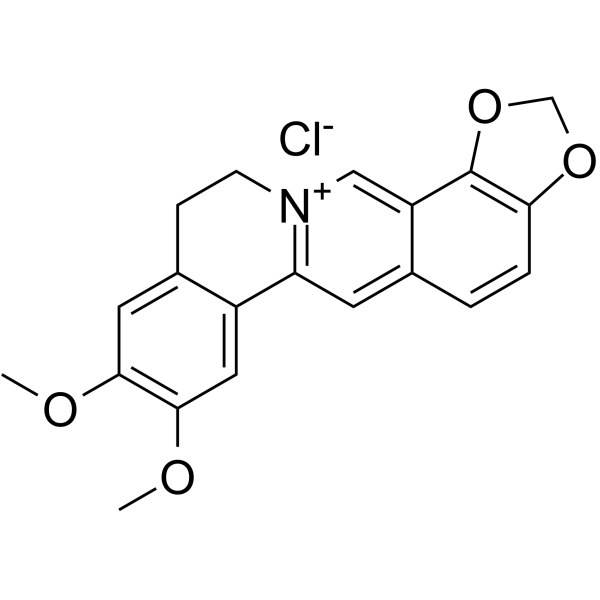All AbMole products are for research use only, cannot be used for human consumption.

Epiberberine chloride is an alkaloid isolated from Coptis chinensis, acts as a potent AChE and BChE inhibitor, and a non-competitive BACE1 inhibitor, with IC50s of 1.07, 6.03 and 8.55 μM, respectively. Epiberberine chloride has antioxidant activity, with peroxynitrite ONOO- scavenging effect (IC50, 16.83 μM), and may protect against Alzheimer disease. Epiberberine chloride inhibits the early stage of differentiation of 3T3-L1 preadipocytes, downregulates the Raf/MEK1/2/ERK1/2 and AMPKα/Akt pathways. Epiberberine has the potential effect in the research of diabetic disease.
| Molecular Weight | 371.81 |
| CAS Number | 889665-86-5 |
| Solubility (25°C) | DMSO 25 mg/mL |
| Storage | 2-8°C, dry, sealed |
| Related AChR/AChE Products |
|---|
| Methoctramine tetrahydrochloride
Methoctramine tetrahydrochloride is a potent and cardioselectivity antagonist of M2 muscarinic receptor. |
| AT 1001
AT 1001 is a high-affinity and selective antagonist of the α3β4 nicotinic acetylcholine receptor (α3β4 nAChR) with Ki of 2.64 nM. |
| Dihydro-β-erythroidine hydrobromide
Dihydro-β-erythroidine hydrobromide is a potent, orally active, and competitive antagonist of neuronal nAChRs. Dihydro-β-erythroidine hydrobromide shows selectivity for α4β4 and α4β2 nAChRs, with IC50s of 0.19 and 0.37 μM, respectively. |
| Spinosad
Spinosad, a mixture of spinosyns A and D known as fermentation products of a soil actinomycete (Saccharopolyspora spinosa), is a biological neurotoxic insecticide with a broader action spectrum. Spinosad targets the nicotinic acetylcholine receptor (nAChRs) of the insect nervous system. |
| TAE-1
TAE-1 is a potent inhibitor of AChE and BuChE. |
All AbMole products are for research use only, cannot be used for human consumption or veterinary use. We do not provide products or services to individuals. Please comply with the intended use and do not use AbMole products for any other purpose.


Products are for research use only. Not for human use. We do not sell to patients.
© Copyright 2010-2024 AbMole BioScience. All Rights Reserved.
